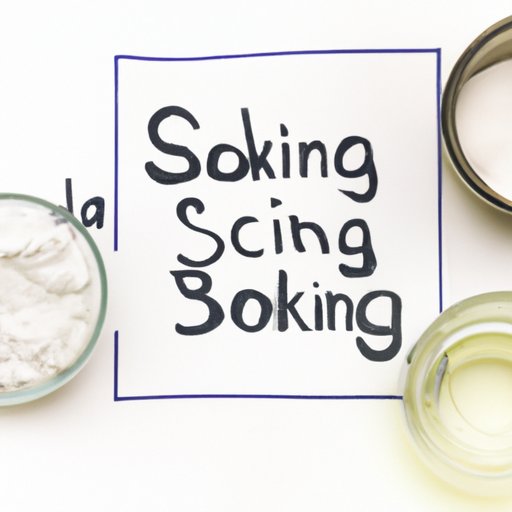
Introduction
Baking enthusiasts understand the importance of having the right ingredients at their disposal to create the perfect recipe. However, sometimes a recipe calls for a specific ingredient that is not available, and substitute ingredients have to be used. One of the most common substitutions is swapping baking soda for baking powder and vice versa depending on what is available in the pantry. This article is a comprehensive guide on how to substitute baking soda for baking powder and will cover the various methods and recipes where this substitution is appropriate.
Baking Soda vs. Baking Powder: What’s the Difference and How to Make the Substitution
The difference between baking powder and baking soda is chemical. Baking powder is a combination of bicarbonate soda, a dry acid (such as cream of tartar), and cornstarch. Baking soda, on the other hand, is purely bicarbonate soda. Baking powder is used for recipes that call for an acidic ingredient, while baking soda is used for acidic recipes or for neutralizing acid. It is essential to understand the chemical composition of baking soda and baking powder to ensure that the proper substitution is made.
Substituting baking soda for baking powder is relatively easy. For one teaspoon of baking powder, combine 1/2 teaspoon baking soda with 1/2 teaspoon cream of tartar. Alternatively, mix one-quarter teaspoon baking soda with a 1/2 teaspoon of lemon juice or vinegar. For one teaspoon of baking soda, use 4 teaspoons of baking powder. However, it’s essential to note that the final outcome of the recipe may differ slightly due to the taste and appearance because of the acidic properties of baking soda.
5 Recipes That Use Baking Soda Instead of Baking Powder
There are several recipes where substituting baking soda for baking powder is ideal.
1. Chocolate Brownies
To substitute 1 teaspoon of baking powder, use 1/4 teaspoon baking soda and 1/2 teaspoon cream of tartar. The combination of the two will help the brownies rise while still maintaining their dense consistency.
2. Chocolate Cake
To substitute 1 teaspoon of baking powder, use 1/4 teaspoon of baking soda and 1/2 teaspoon of vinegar or lemon juice. Adjust the recipe to achieve the desired taste and texture.
3. Oatmeal cookies
To substitute 1 teaspoon of baking powder, use 1/4 teaspoon of baking soda. Oatmeal cookies typically do not need to rise as much, so the 1/4 teaspoon of baking soda will help the cookies maintain their texture.
4. Peanut butter cookies
To substitute one teaspoon of baking powder, use 1/4 teaspoon of baking soda and 1/4 teaspoon of cream of tartar. The peanut butter in the cookie recipe adds enough acidity, so 1/4 teaspoon of baking soda provides just enough rise.
5. Banana Bread
To substitute one teaspoon of baking powder, use 1/4 teaspoon of baking soda and 1/2 teaspoon of cream of tartar. The combination of baking soda and cream of tartar will provide enough lift despite banana bread’s dense texture.
The Ultimate Guide to Baking Substitutions: How to Make Your Recipes Work with Baking Soda
Baking enthusiasts often run out of essential ingredients while in the middle of a recipe. Knowing how to substitute ingredients is crucial to create the desired outcome. The following are substitutions that can be made for baking powder:
1. Club soda
Club soda and seltzer water can be used as a baking powder substitute. For one teaspoon of baking powder, mix one-quarter cup of club soda. Be sure to adjust the recipe based on the taste and texture desired.
2. Whipping cream
Whipping cream is an excellent ingredient to use for recipes that require baking powder. For one teaspoon of baking powder, mix one-quarter cup of whipping cream into the recipe. The whipping cream helps the recipe rise while keeping things smooth.
3. Yogurt
Yogurt is an excellent substitute for baking powder, especially for recipes that require a tang. For one teaspoon of baking powder, mix one-quarter cup of yogurt into the recipe.
Baking Without Powder: How to Get Perfect Results with Baking Soda
While baking powder and baking soda can be used interchangeably, some people prefer using baking soda over baking powder for the following reasons:
Taste
Baking soda has an alkaline taste, while baking powder has an acidic taste. In recipes that call for acidic ingredients, baking soda can help to balance out the flavor.
Budget-friendly
Baking soda is typically less expensive than baking powder, making it a budget-friendly ingredient option when baking.
Baking Powder or Baking Soda: Which One Should You Use?
Choosing between baking powder and baking soda can be challenging. The general rule is to use baking powder for non-acidic batters, while baking soda is ideal for acidic batters. However, the decision isn’t always that black and white. When in doubt, use a bit of both and experiment with different flavors and textures until the desired outcome is achieved.
Conclusion
Understanding the differences between baking soda and baking powder is crucial to substitute them for each other. With this comprehensive guide, baking enthusiasts can experiment with different flavors and textures to create perfect baked goods using baking soda. The right knowledge, coupled with trial and error, will help create the most delicious baked goods possible without worry even if they run out of certain ingredients like baking powder or baking soda in the middle of the recipe.




